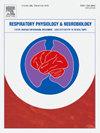Phrenic motor output following acute hyperbaric oxygen exposure
IF 1.6
4区 医学
Q3 PHYSIOLOGY
引用次数: 0
Abstract
We studied adult male rats to determine if phrenic motor output is altered following acute hyperbaric oxygen (HBO) pretreatment. Rats were treated with 1-h of 100 % O2 at 2 atmospheres (HBO, n = 12) or 21 % O2 at 1 atmosphere (normoxia, n = 12) and then anesthetized and ventilated to enable phrenic nerve recordings. Baseline phrenic output and blood pressure were similar between groups. Sixty minutes after exposure to acute intermittent hypoxia (AIH), inspiratory phrenic burst amplitude was +66 ± 47 (HBO) and +43 ± 13 % baseline (normoxia). Thus, both groups expressed phrenic long-term facilitation, pLTF (time effect, P = 0.008). The pLTF magnitude had a larger coefficient of variation after HBO (71 %) vs. normoxia (30 %). This resulted from a bimodal data distribution, with 4 of 12 HBO rats showing pLTF > +70 % baseline (vs. 0 of 12 normoxia). We conclude that acute HBO does not impact baseline phrenic output in this preparation, but further study of HBO and phrenic neuroplasticity is warranted.
急性高压氧暴露后膈肌运动输出。
我们研究了成年雄性大鼠,以确定急性高压氧(HBO)预处理后膈肌运动输出是否发生改变。大鼠给予2个大气压下100% O2 (HBO, n=12)或1个大气压下21% O2(常氧,n=12)治疗1小时,然后麻醉和通气,以便膈神经记录。两组间基线膈气量和血压相似。暴露于急性间歇缺氧(AIH) 60分钟后,吸气性膈破裂幅度为+66±47 (HBO)和+43±13%基线(常氧)。两组均表达膈长期促进,pLTF(时间效应,P=0.008)。高压氧治疗后pLTF大小的变异系数(71%)大于常氧治疗后(30%)。这是由双峰数据分布导致的,12只HBO大鼠中有4只显示pLTF bb0 +70%基线(12只正常缺氧大鼠中0只)。我们得出结论,急性高压氧不影响基线膈输出,但进一步研究高压氧和膈神经可塑性是有必要的。
本文章由计算机程序翻译,如有差异,请以英文原文为准。
求助全文
约1分钟内获得全文
求助全文
来源期刊
CiteScore
4.80
自引率
8.70%
发文量
104
审稿时长
54 days
期刊介绍:
Respiratory Physiology & Neurobiology (RESPNB) publishes original articles and invited reviews concerning physiology and pathophysiology of respiration in its broadest sense.
Although a special focus is on topics in neurobiology, high quality papers in respiratory molecular and cellular biology are also welcome, as are high-quality papers in traditional areas, such as:
-Mechanics of breathing-
Gas exchange and acid-base balance-
Respiration at rest and exercise-
Respiration in unusual conditions, like high or low pressure or changes of temperature, low ambient oxygen-
Embryonic and adult respiration-
Comparative respiratory physiology.
Papers on clinical aspects, original methods, as well as theoretical papers are also considered as long as they foster the understanding of respiratory physiology and pathophysiology.

 求助内容:
求助内容: 应助结果提醒方式:
应助结果提醒方式:


